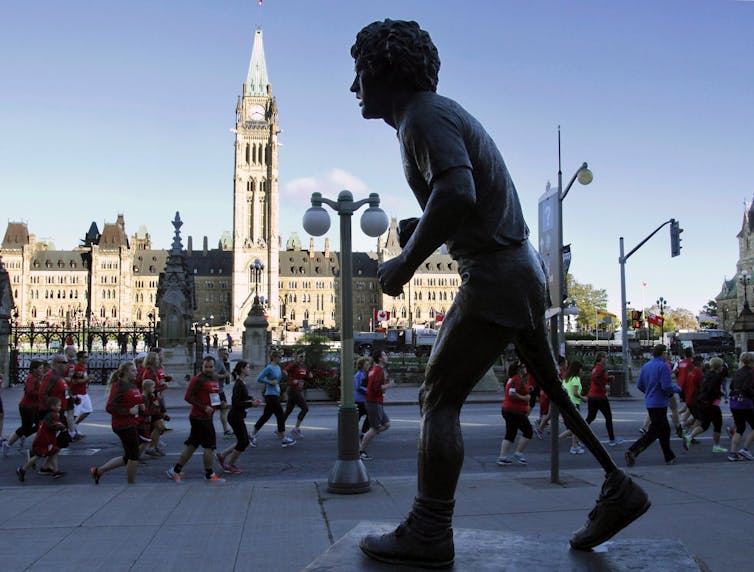Grace McNutt, PhD Candidate in History, Dalhousie University
One of the first things that happened when the so-called “freedom convoy” arrived in Ottawa was that anti-vaccine mandate protesters defaced a statue of Terry Fox near Parliament Hill. The statue was draped in Canadian flags and had a sign that read “Mandate Freedom” wedged under its arm.
There was an immediate backlash on social media at the sight of a Canadian icon being used in such a political and polarizing way. People immediately took to Twitter to denounce the move.
Canadians coming to the defence of Terry Fox’s legacy is not surprising. He regularly ranks as one of the greatest Canadians. Furthermore, the irony of connecting an anti-vaccine movement with a man who ran more than 5,000 kilometres in support of medical research was not lost on most people.
But Canadians vehemently defending a statue is surprising. I have been interested in statue removals since 2018, when Halifax officials responded to a white supremacy demonstration by removing a contentious statue of the city’s founder, Edward Cornwallis. Now, my PhD studies at Dalhousie University focus on understanding why we have such complicated, controversial relationships with statues. During this time, there have been far more statues condemned than endorsed.
Those who disparaged the removal of statues claimed this was a slippery slope. Soon, all statues would be dispensable. Regardless of intentions, the Freedom Convoy protesters inadvertently proved them dead wrong.
A long, storied history
Statue defacing and removal is an evocative method of protest, especially when used by marginalized people challenging systemic discrimination. While the tactic predates the murder of George Floyd and the rise of Black Live Matter, the movement heavily utilized statue defacing to confront Confederate iconography, white supremacy, and ongoing racial discrimination.
Similar protests were carried out globally. The responses from officials were wide ranging, from removal, to re-interpretation, to leaving or reinstalling statues. The strategy spread to other movements, in particular Indigenous rights and anti-colonization movements.
Last summer, over 1,000 bodies of Indigenous children were found in unmarked graves at former Indian Residential Schools across Canada. Graves of this nature have been found dating back to the 1990s and confirmed what Indigenous people have known for decades.
Vandalizing statues that commemorated architects of settler-colonialism in Canada became a regular symbol of resistance. Statues of John A. Macdonald, Egerton Ryerson and Hector-Louis Langevin, a proponent of the residential school system, were among the targets. Statues were painted red, covered in graffiti, toppled, and even decapitated.
Sheila North, former Grand Chief of Manitoba Keewatinowi Okimakanak, told Global News: “These things (monuments) are perpetuating the racism and perpetuating the hatred towards Indigenous people without even realizing.”
Easily debunked arguments
In general, proponents for keeping the statues consistently present two arguments. The first is that the removal of a statue is the equivalent of erasing history.
This argument does not hold much water for researchers of commemoration and heritage. More often than not, statues do a pretty poor job of interpreting and educating about the past. That’s because statues are not history; they are heritage. History is the analytical observation of the past. Heritage is the emotional, somewhat nostalgic desire to represent the past in the present.
Removing a statue does not erase our knowledge of the person or event being commemorated. Instead, it declares that we no longer want to commemorate this part of our past as a reflection of our present values.

The second argument proponents of statues tout — and the one that brings us back to the Terry Fox memorial — is that this is a slippery slope. As statue removals increase, some believe there will be no statues left.
In the age of social media and cancel culture, the argument goes, anything can cause outrage. We are walking on eggshells to ensure we do not say anything to offend. Furthermore, we should not evaluate people of the past by modern standards: they were only acting in accordance with the period. So, while John A. Macdonald may have done some bad things to Indigenous Peoples, if we take down his statue, it will open the door to any statue being torn down for the slightest offence.
An opportunity for new heroes
What happened to the Terry Fox statue silenced the slippery slope argument. When those opposed to vaccine measures adorned the Terry Fox memorial as part of their so-called freedom campaign, people quickly saw through the demonstration.
Despite all the calls for statue removals over the last two years, the public still finds value in heritage and sought to protect a memorial which continues to represent their values.
After Terry Fox succumbed to cancer in 1981, then Prime Minister Pierre Elliot Trudeau addressed the nation: “It occurs very rarely in the life of a nation, that the courageous spirit of one person unites all people.”
In a country that has long claimed to promote diversity over homogeneity, unifying national heroes are hard to come by. And as we are increasingly confronted with the mistakes and horrors of our national past and present, the national heroes we do have must be reassessed and scrutinized carefully.
But, the removal of their statues do not symbolize the death of history or the loss of heroes. Rather, it is an opportunity for new, inspiring figures to be brought to the forefront.![]()
This article is republished from The Conversation under a Creative Commons license. Read the original article.

